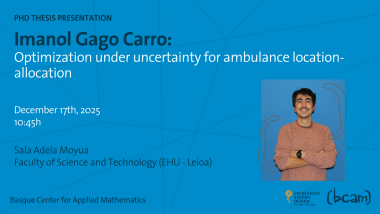Tresna matematiko adimendunak: teknika moldakor berriek kalkulu-ahalegina bideratzen dute zehaztasuna handitzeko eta baliabideak aurrezteko
- Judit Muñoz Matute doktoreak Discontinuous Petrov-Galerkin (DPG) metodologian oinarritutako espazio-denborako teknika moldakor egonkortuen diseinuan jarri du arreta.
- Metodologia aurreratu hau denboran aldatzen diren deribatu partzialetako ekuazioak (EDPak) modu eraginkorrean tratatzeko garatu da, bereziki adbekzioak nagusitutako difusio-problemak eta uhin-hedapeneko arazoak barne hartzen dituztenean.
- Metodo hauen azken aplikazioa irudi sismikoa hobetzea da; hori funtsezko urratsa da lurpeko karbono-harrapaketa eta -biltegiratzea (CO₂) seguruagoa eta fidagarriagoa izan dadin, klima-aldaketaren aurkako borrokan ezinbesteko prozesua baita.
- Emaitzak CORDISen argitaratutako Results in Brief artikulu batean jaso dira.
Karbono dioxidoa (CO₂) lur azpian biltegiratzea klima-aldaketaren aurkako borroka globalean ezinbesteko tresnatzat jotzen da. Hala ere, proiektu horien bideragarritasuna lurpeko formazio geologikoei buruzko ezagutza zehatz eta fidagarria izatearen menpe dago.
Premia horri erantzun zion Europar Batasunak finantzatutako GEODPG proiektuak, Basque Center for Applied Mathematics (BCAM) erakundeak koordinatua. Judit Muñoz Matutek gidatuta (BCAMeko ESM eta EHUko Ikerbasque ikertzailea), GEODPGk lurpeko prozesu fisikoak deskribatzen dituzten ekuazio konplexuak ebazteko modu adimentsuagoak diseinatzea izan zuen helburu. Marie Skłodowska-Curie Actions programaren babesarekin, proiektua 2022tik 2025era garatu zen.
Proiektuaren muina deribatu partzialetako ekuazioak ebazteko metodo aurreratuen garapenean dago, bereziki uhin-hedapena deskribatzen dutenetan. Emaitza nagusietako bat teknika numeriko oso eraginkor eta zehatzen diseinua izan da, tartean espazio-denborako DPG metodo moldakor berritzailea.
Muñoz Matutek azaldu duenez:
“Eskualde edo une batzuk beste batzuk baino konplexuagoak dira eta bereizmen handiagoa behar dute. Espazio-denborako teknika moldakorrek automatikoki bideratzen dute kalkulu-ahalegina beharrezkoa den tokira, eta denbora eta baliabideak aurrezten dituzte beste leku batzuetan. DPG metodoak emaitzek zehaztasuna mantentzen dutela bermatzen du, baita oso erronka handiko arazoetan ere.”
Ikuspegi horri esker, baliabide konputazionalak oso modu eraginkorrean erabil daitezke, sendotasuna eta zehaztasuna galdu gabe.
Teknika hauek hainbat esparrutan aplika daitezkeen arren —geofisikan, besteak beste—, aplikazio horiek erabilera potentzialak dira, ez ikerketaren ardatz nagusia. Testuinguru zabalago batean, berrikuntza matematiko eta konputazionalek hainbat aplikazio zientifiko eta ingeniaritzako lagunduko dituztela espero da, hala nola lurpeko egituren berreraikuntza zehatzagoak edo anomalia sotilen identifikazioa, arlo bakar batera mugatu gabe.
Muñoz Matuterentzat, proiektuak matematika arazo global larriei aurre egiteko erabiltzeko duen grina islatzen du:
“Uhinak nola mugitzen diren azaltzen duten ideia berberek klima-aldaketaren aurkako borrokan ere lagun dezakete. Oso pozgarria da gure planeta babesteko tresna matematikoak garatzen laguntzea.”
Hurrengo urratsen artean metodoak arazo konplexuagoetara hedatzea eta adimen artifizialarekin sinergiak aztertzea daude. Hurrengo hamarkadan, lan honek tresna indartsu berriak eskainiko dituela espero du, ez bakarrik geofisikarako, baita biologia konputazionalerako ere.
GEODPGren arrakastak BCAMek modelizazio aplikatu aurreratuan duen sendotasuna azpimarratzen du. Proiektuan zehar, Judit Muñoz Matute doktorego ondoko ikertzailea izan zen zentroko Diseinu Matematikoa, Modelizazioa eta Simulazioak ikerketa-ildoan. Lan hau BCAMeko beste matematikari ospetsu batzuen ikerketekin bat dator, hala nola David Pardo irakaslearenarekin, geofisikako fluxuetarako metodo numerikoetan lan egiten duten taldeak gidatzen baititu.
Emaitzak CORDISen Results in Brief artikulu batean argitaratu dira (2025eko azaroa), matematika abstraktua klima-ekintzarako tresna praktiko bihurtzeko adibide arrakastatsu gisa.
Related news
Emakumeak zientzian




